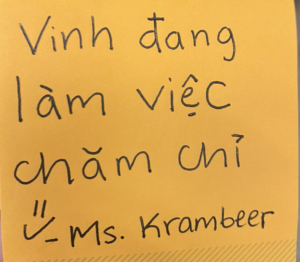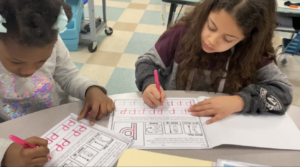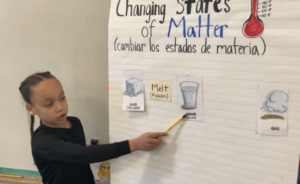With the gradual release of responsibility, I slowly took on more responsibility for planning and instruction as the year progressed. My primary roles at the start of the year were science instruction and interactive read-alouds. During other parts of the day, I did small group work and assisted individual students who needed redirection or more support to access the lesson. This responsibility grew throughout the fall until my takeover in the spring.
In all aspects of planning, I was responsible for planning for and teaching with scaffolds to reduce environmental barriers faced by my students. Such environmental barriers were associated with communication, cognitive development, English language acquisition, executive function, Apraxia, and trauma. Many of the accommodations necessary were a direct response to unmet learning needs during the pandemic.
Morning meeting
In the mornings, I shared the preparation for our morning meeting and morning work with my mentor teacher. This involved selecting math problems that students could complete independently as they arrived and finished breakfast. After announcements, we co-led a morning greeting and share for the class and reviewed our socioemotional goal for the week (our ‘Monday Mindset’). During prep/lunchtime, I graded students’ morning work – intentionally leaving encouraging comments on student work and modeling how to complete the problems for absent students so they wouldn’t be confused when they returned.
Homework

My mentor teacher and I worked together to pull and create weekly homework packets for the students throughout the year. From the first week of the school year, I was responsible for grading and passing back homework to students. When grading homework, I worked to give students positive feedback on their work. When possible, I would also try to send notes of encouragement home with students to their caregivers in their preferred language. Students were often excited to tell me what their caregivers said when they showed them their feedback. I noticed that this communication seemed to encourage students to turn in their homework consistently.
English Language Arts

In order to best meet student needs, our ELA block was split into three teacher-led centers between my mentor teacher, myself, and our push-in ELA Teacher, Mr. A. My responsibilities included planning and teaching a 30-minute lesson to differentiated groups every morning. In the late spring, the content covered included letter formation, multiple-meaning words, synonyms, and figurative language.
Math

Around September, I began to take half of the class for math stations after my mentor teacher or I taught the whole group math lesson. My mentor teacher would then work with the students who needed more support while I would work with students who were ready for more of a challenge on fact fluency and number sense. In the spring, I began to take over more of the math instruction – beginning with my data unit in February. In order to prepare students as best as we could for math MCAS, we split the class in half and taught two topics simultaneously. We rotated groups or alternated days with groups depending on the length of our math block. This model ensured that we were able to appropriately scaffold each lesson to meet student needs, fill pandemic-related gaps in knowledge that were exacerbated by student circumstances, and ensure that students were receiving grade-level content.
During math instruction, I was able to work to encourage students to work with partners after co-constructing a math partner contract. This was incredible progress for our classroom as behavioral and developmental challenges had prevented successful group work in the past.
District-adopted curriculum (Envisions) was not developmentally or academically appropriate or accessible in our classroom, and thus my mentor teacher and I worked closely to develop our own math instruction that focused directly on the standards and gave students flexible means of demonstrating mastery whenever possible.
Social Studies
I took over social studies instruction in November when I taught a unit on human migration. During this unit, students learned how to conduct an interview and interviewed an adult who had moved before. Students were able to share about the person they interviewed with their peers. This was a very exciting unit for students and a really nice way for me to build a positive relationship with their caregivers. After this unit, my mentor teacher and I took turns planning and co-taught the following topics throughout the rest of the year.
Science
From the beginning of the school year, I took over full responsibility for planning and teaching science lessons. Using district-provided and other resources, I worked to create science lessons that highlighted the Main South neighborhood. During my unit on weather and climate, I gave students the opportunity to share their experiences living in different climates and used photos they brought in throughout the unit.

Interactive Read Aloud

From the beginning of the year, I took over Interactive Read Alouds. Sometimes these read-alouds connected to my science instruction, and other times they connected to socioemotional learning goals. My mentor and I collaborated together to identify books that represented the numerous identities of the students in our classroom. In the fall, my mentor teacher and I co-taught a non-fiction genre unit. In the spring, I taught units on Fables, Fairytales, and Folktales – as an interactive read-aloud and writing unit.
Response to Intervention (RTI)
In the fall I led a thirty-minute math intervention group and in the spring, I led a 20-minute ELA intervention group. Both groups focused on skills that students needed to master in order to access grade-level content. My mentor and I analyzed data from Star Testing to determine how to create groups.
Classroom Management
Due to the emotional and safety needs of the students in our classroom, my mentor teacher and I worked closely with the behavioral support staff at our school to support students. This involved tracking student behavior on detailed logs and providing students with accountability checklists.
Other responsibilities
When my mentor teacher was out, had a meeting, or professional development, I substituted for our classroom. I also had duties including recess and dismissal duty.